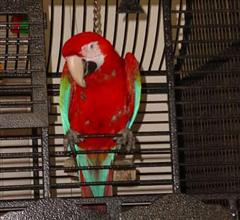Macaw - Green Winged
Greenwing Macaw, Maroon Macaw, Red and Green Macaw, Red and Blue Macaw Scientific Name: Ara chloroptera
Tue, 15th July, 2025 - 9:39 pm GMT
Sponsor Ads:

Alternative Name
Greenwing Macaw, Maroon Macaw, Red and Green Macaw, Red and Blue Macaw Scientific Name: Ara chloropteraBasic Info
Red and Green Macaws grow to about 26 to 37 inches in length and have a 41 to 49 inch wingspan! They have red plumage with blue back, rump, and tail converts. The bare facial patch is crossed with red feather lines. Green Winged Macaws have green shoulders and inner secondary and median wing coverts; the rest of the wings are blue. Green Winged Macaws have blue edged red tail feathers, and males may have green edged feathers at the backs of their heads. The bill is horn colored and prominent with black edges and a black lower mandible, and the feet are dark gray.
Health
Red and Green Macaws may become nippy and fearful if not socialized properly from a young age. Be sure to check peanuts and Brazil nuts for mold before feeding them to your Greenwing Macaw. They need to be dried upon bathing, either in the sun outdoors or indoors with a hairdryer. Green Winged Macaws need plenty of room to fly or their wing muscles will atrophy. Many people clip the primary flight feathers to allow their birds to glide but not fly. Green Winged Macaws are quite susceptible to Macaw Wasting Disease or Proventricular Dilatation Disease; Chlamidia or Psittacosis; oral or cloacal papillomas; bacterial, viral, and fungal infections; pancreatitis; allergies, especially to cockatoos; feather picking, toxicity and heavy metal poisoning; kidney disease or gout; Aspergillosis; and in juveniles and chicks, flight and tail feather chewing, beak malformation, and Constricted Toe Syndrome. Breeding Green Winged Macaws in captivity breed during the spring and may become aggressive, attacking like sized birds and their handlers. They should be provided with a two by three by four foot horizontally oriented nesting box bedded with pine shavings. Some prefer a vertical two by two by three foot nesting box. Most breeding failures may have to do with Green Winged Macaw's fussiness about nesting box sites. The clutch consists of about three eggs, not all of which may be fertile, and the nesting box should be absolutely undisturbed less the parents damage or destroy the eggs out of fright. Red and Green Macaws should have higher fat in their diets during the breeding season. Eggs incubate for 23 to 27 days and the fledgling period lasts 12 weeks. The young should remain with the parent Green Winged Macaws for a few weeks after independence before hand feeding commences. In the wild, reproductive success is low; pairs do not breed each year, and predation and disease in addition to flooding obliterate eggs. Green Winged Macaws develop down feathers at eight days of age and feather sheaths at three weeks of age. They open their eyes at approximately two weeks of age.Habitat
It is found in the Guyanas, Panama, Bolivia, Suriname, Brazil, Peru, Columbia, Ecuador, Paraguay, and Argentina.Behavior
The Green Winged Macaw, a beautiful bird, makes a friendly and feisty pet for those who can accommodate a noisy bird! They are the world's second largest Macaw! The Green Winged Macaw, or Red and Green Macaw, lives in social groups of six to 12 birds in forest land and often associates with Scarlet and Blue and Yellow Macaws. They prefer to stay shyly in the treetops and are quite cautious when on the ground. Red and Green Macaws build their nests high in trees or cliffs, breeding from November through March. They visit clay banks regularly, eating mineral soil to neutralize toxins found in the unripe fruit they subsist on. Green Winged Macaws also eat nuts, seeds, berries, greenery, and ripe fruit. Though they are less active than other Macaws, in captivity Green Winged Macaws need a large outdoor aviary of 24 by nine by six feet with an enclosed shelter, constructed of strong wire or chain link. These birds are avid chewers and need plenty of wood, as bored Green Winged Macaws will be destructive, chewing on their cage or anything else they can find! They enjoy bathing and should always have fresh water.Green Winged Macaws live nicely with other birds and form strong bonds with their keepers. They may become aggressive during breeding season, however, when they should be treated cautiously.Origin
South AmericaHistory
Native to tropical forests at 1500 and occasionally 4700 feet, the Red and Green Macaw is also called the Maroon Macaw, the Greenwing Macaw, and the Red and Blue Macaw. Though it is not listed as threatened, the Greenwing Macaw's habitat is being destroyed and it has disappeared in much of Panama due to trapping for trade and hunting for food.Common Foods
Green Winged Macaws should be fed a wide variety of fruits and vegetables, greens, grains, nuts, seeds, and a mineral supplement along with peanut butter or other fatty, high-protein treats. They may be hand-reared on biscuit, porridge, and white bread.Sponsor Ads:
There's only one way to have a happy marriage and as soon as I learn what it is I'll get married again. -- Clint Eastwood
Macaw - Green Winged
Coded by: BGID® | ALL RIGHTS RESERVED Copyright © 2000-2025
Disclaimer | Privacy | Report Errors / Contact | Credits








 Preparing For China. China is growing their military. China Military Technology - can it keep up with the US?
Preparing For China. China is growing their military. China Military Technology - can it keep up with the US?  versus
versus 

 versus
versus 
 This Thread is about the North Korean Military itself - the kind of army, navy, and air force they have.
This Thread is about the North Korean Military itself - the kind of army, navy, and air force they have. 
 versus
versus 
 versus
versus  versus
versus